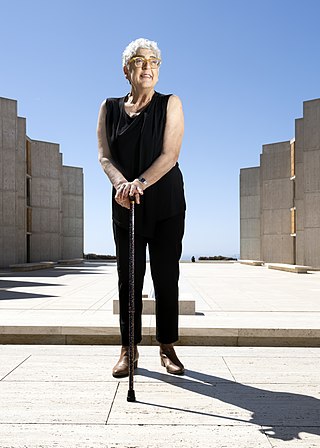
Scientific American, informally abbreviated SciAm or sometimes SA, is an American popular science magazine. Many scientists, including Albert Einstein and Nikola Tesla, have contributed articles to it, with more than 150 Nobel Prize-winners being featured since its inception.

The giant pouched rats of sub-Saharan Africa are large muroid rodents.

Male pregnancy is the incubation of one or more embryos or fetuses by organisms of the male sex in some species. Most species that reproduce by sexual reproduction are heterogamous—females producing larger gametes (ova) and males producing smaller gametes (sperm). In nearly all animal species, offspring are carried by the female until birth, but in fish of the family Syngnathidae, males perform that function.

Dmitry Konstantinovich Belyayev was a Soviet geneticist and academician who served as director of the Institute of Cytology and Genetics (IC&G) of the USSR Academy of Sciences, Novosibirsk, from 1959 to 1985. His decades-long effort to breed domesticated silver foxes was described by The New York Times as “arguably the most extraordinary breeding experiment ever conducted.” A 2010 article in Scientific American stated that Belyayev “may be the man most responsible for our understanding of the process by which wolves were domesticated into our canine companions.”

Elaine V. Fuchs is an American cell biologist known for her work on the biology and molecular mechanisms of mammalian skin and skin diseases, who helped lead the modernization of dermatology. Fuchs pioneered reverse genetics approaches, which assess protein function first and then assess its role in development and disease. In particular, Fuchs researches skin stem cells and their production of hair and skin. She is an investigator at the Howard Hughes Medical Institute and the Rebecca C. Lancefield Professor of Mammalian Cell Biology and Development at The Rockefeller University.

The Gambian pouched rat, also commonly known as the African giant pouched rat, is a species of nocturnal pouched rat of the giant pouched rat genus Cricetomys, in the family Nesomyidae. It is among the largest muroids in the world, growing to about 0.9 m (3 ft) long, including the tail, which makes up half of its total length. It is widespread in sub-Saharan Africa, ranging from Senegal to Kenya and from Angola to Mozambique from sea level to 2,000 m (6,600 ft).
Brigid L. M. Hogan FRS is a British developmental biologist noted for her contributions to mammalian development, stem cell research and transgenic technology and techniques. She is currently a Professor in the Department of Cell Biology at Duke University, Born in the UK, she became an American citizen in 2000.

Hemimeridae is a family of earwigs in the suborder Neodermaptera. Hemimeridae was formerly considered a suborder, Hemimerina, but was reduced in rank to family and included in the new suborder Neodermaptera.

The southern giant pouched rat is a species of rodent in the family Nesomyidae. It is distributed in the savannah of East and Southern Africa.

Pamela Christine Ronald is an American plant pathologist and geneticist. She is a professor in the Department of Plant Pathology and conducts research at the Genome Center at the University of California, Davis and a member of the Innovative Genomics Institute at the University of California, Berkeley. She also serves as Director of Grass Genetics at the Joint BioEnergy Institute in Emeryville, California. In 2018 she served as a visiting professor at Stanford University in the Center on Food Security and the Environment.

Ainissa Ramirez is an American materials scientist and science communicator.

Joanne Chory is an American plant biologist and geneticist. Chory is a professor and director of the Plant Molecular and Cellular Biology Laboratory, at the Salk Institute for Biological Studies and an investigator of the Howard Hughes Medical Institute.

Kay M. Tye is an American neuroscientist and professor and Wylie Vale Chair in the Salk Institute for Biological Sciences. Her research has focused on using optogenetics to identify connections in the brain that are involved in innate emotion, motivation and social behaviors.
Jedidah C. Isler is an American astrophysicist, educator, and an active advocate for diversity in STEM. She became the first African-American woman to complete her PhD in astrophysics at Yale in 2014. She is currently an assistant professor of astrophysics at Dartmouth College. Her research explores the physics of blazars and examines the jet streams emanating from them. In November 2020, Isler was named a member of Joe Biden's presidential transition Agency Review Team to support transition efforts related to the National Aeronautics and Space Administration.

Meghan Anne Duffy is an American biologist and the Susan S. Kilham Collegiate Professor of Ecology and Evolutionary Biology at the University of Michigan. She focuses on the causes and consequences of parasitism in natural populations of lake populations. In 2019, she created a task force to examine factors that influence the mental health and well-being of graduate students at the University of Michigan.

Patience Mthunzi-Kufa is a South African physicist and head of biophotonics research at the Council for Scientific and Industrial Research. She received the Order of Mapungubwe in Bronze.

Nina Dudnik is an American social entrepreneur, science diplomacy advocate, and the Founder and former CEO of Seeding Labs, a US-based nonprofit organization investing in building scientific capacity in the developing world. Dudnik founded the organization in 2003 as a graduate student studying at Harvard University, where she received her PhD in molecular biology.

Rebecca Marie Calisi is an American neuroendocrinologist, wildlife biologist, and National Geographic Explorer. She is an Associate professor of Neurobiology, Physiology, and Behavior in the College of Biological Sciences at the University of California, Davis. She leads a research team that studies how the brain controls sexual behavior, reproduction, and parental care, and how this changes under stress. As the Director for Science Communications at UC Davis, she studies science communication and advocates for inclusivity, equity, and diversity in STEM.

Christian Happi is a Professor of Molecular Biology and Genomics in the Department of Biological Sciences and the Director of the African Centre of Excellence for Genomics of Infectious Diseases, both at Redeemer’s University. He is known for leading the team of scientists that used genomic sequencing to identify a single point of infection from an animal reservoir to a human in the Ebola outbreak in West Africa. His research focus is on infectious diseases, including malaria, Lassa fever, Ebola virus disease, HIV, and SARS-CoV-2.
Yara Haridy is an Egyptian-Canadian paleontologist and scientific communicator who specializes in the use of advanced analytical methods to study the evolution of bone and related skeletal tissues.
















